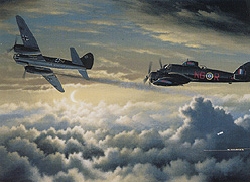|
|
| Double Trouble |
|
 |

|
 |
|
|
| DESCRIPTION |
 |
| 16 x 11.5 Inch Collector Size Unframed Lithograph $40.00
The Bristol Beaufighter was one of the most successful twin-engine fighters utilized by the RAF during WW II. The forerunner of the Beaufighter was the Bristol Beaufort which was the first modern torpedo bomber to enter service. The Beaufort known officially as the Type-152 was derived from the earlier Type-150 which in turn had been influenced by the Bristol Blenheim. About the time the first Beauforts were being flight tested the aircraft's chief designer Leslie Frise commenced a study to see if the Beaufort's airframe could be adapted to create a twin engine fighter design. The modified design (Type-156) incorporated a narrower fuselage a shorter nose section utilizing a single-seat cockpit and a dorsal observer's position. The prototype Beaufighter made its first flight in July of 1939. A year of flight testing and refinement followed. Only Hercules III engines were available for the first production models. This gave the first marks performance roughly comparable to a Hawker Hurricane. Most Beaus were armed with four nose-mounted canon and an additional six machine guns in the wings. This gave the Beaufighter an impressive amount of firepower. As the Battle of Britain raged priority was given to modifying existing aircraft to the night fighter role. German bombers were relatively free from RAF fighters when attacking at night. The Beaufighter represented an ideal platform for this night fighter role. It was fast enough at 360-MPH to catch German bombers it was heavily armed and the observers position was an ideal spot to incorporate a radar operators controls. These night fighter versions were painted a matte black. On October 25 1940 a Beaufighter recorded its first night victory. The Beaus utilized a transmitting antenna mounted on the nose and receiving antennas mounted on the leading section of both wings. As the War progressed the Beaufighter would also become an important ground attack and fighter/bomber for the RAF. As depicted in Stan Stokes' dramatic painting entitled Double Trouble an RAF Beaufighter piloted by Group Captain John Cunningham downs a Ju-88 bomber. Cunningham was the RAF's top night fighter ace. He and his radar operator Jimmy Rawnsley were credited with nineteen night victories. Cunningham also downed one enemy aircraft during daylight. He served with No. 604 Squadron which had both a day and night fighter capability. The squadron's night fighting proficiency rose dramatically from late 1940 until mid-1941. By 1943 the Beaufighters were replaced with faster Mosquitoes. Cunningham was demobilized following the War. He joined DeHavilland Aircraft as its Chief Test Pilot following the War and retired from British Aerospace in 1980. |
|


|